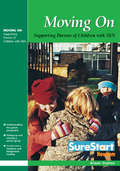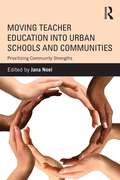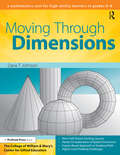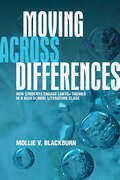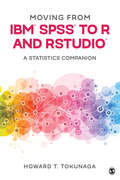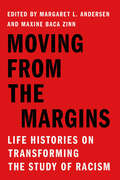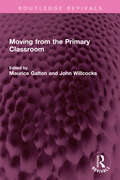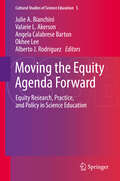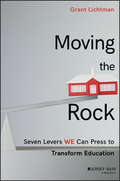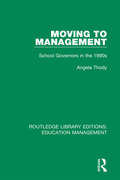- Table View
- List View
Moving On: Supporting Parents of Children with Special Educational Needs
by Allison OrphanFirst Published in 2004. Routledge is an imprint of Taylor & Francis, an informa company.
Moving Teacher Education into Urban Schools and Communities: Prioritizing Community Strengths
by Jana NoelWinner of the 2013 American Educational Studies Association's Critics Choice Award! When teacher education is located on a university campus, set apart from urban schools and communities, it is easy to overlook the realities and challenges communities face as they struggle toward social, economic, cultural, and racial justice. This book describes how teacher education can become a meaningful part of this work, by re-positioning programs directly into urban schools and communities. Situating their work within the theoretical framework of prioritizing community strengths, each set of authors provides a detailed and nuanced description of a teacher education program re-positioned within an urban school or community. Authors describe the process of developing such a relationship, how the university, school, and community became integrated partners in the program, and the impact on participants. As university-based teacher education has come under increased scrutiny for lack of "real world" relevance, this book showcases programs that have successfully navigated the travails of shifting their base directly into urban schools and communities, with evidence of positive outcomes for all involved.
Moving Through Dimensions: A Mathematics Unit for High Ability Learners in Grades 6-8
by Clg Of William And Mary/Ctr Gift EdMoving Through Dimensions approaches spatial reasoning through one-dimensional, two-dimensional, and three-dimensional tasks designed for students in the middle school grades. The unit also asks students to explore the transition between dimensions and representations of three-dimensional objects in two dimensions. This book includes pre- and postassessments, multiple reproducible materials, and lessons based on NCTM standards.Moving Through Dimensions was developed by the Center for Gifted Education at The College of William and Mary to offer advanced curriculum supported by years of research. The Center's materials have received national recognition from the United States Department of Education and the National Association for Gifted Children, and they are widely used both nationally and internationally.Each of the books in this series offers curriculum that focuses on advanced content and higher level processes. The science units contain simulations of real-world problems, and students experience the work of real science by using data-handling skills, analyzing information, and evaluating results. The mathematics units provide sophisticated ideas and concepts, challenging extensions, higher order thinking skills, and opportunities for student exploration based on interest. These materials are a must for any teacher seeking to challenge and engage learners and increase achievement.Grades 6-8
Moving Up without Losing Your Way: The Ethical Costs of Upward Mobility
by Jennifer MortonThe ethical and emotional tolls paid by disadvantaged college students seeking upward mobility and what educators can do to help these students flourishUpward mobility through the path of higher education has been an article of faith for generations of working-class, low-income, and immigrant college students. While we know this path usually entails financial sacrifices and hard work, very little attention has been paid to the deep personal compromises such students have to make as they enter worlds vastly different from their own. Measuring the true cost of higher education for those from disadvantaged backgrounds, Moving Up without Losing Your Way looks at the ethical dilemmas of upward mobility—the broken ties with family and friends, the severed connections with former communities, and the loss of identity—faced by students as they strive to earn a successful place in society.Drawing upon philosophy, social science, personal stories, and interviews, Jennifer Morton reframes the college experience, factoring in not just educational and career opportunities but also essential relationships with family, friends, and community. Finding that student strivers tend to give up the latter for the former, negating their sense of self, Morton seeks to reverse this course. She urges educators to empower students with a new narrative of upward mobility—one that honestly situates ethical costs in historical, social, and economic contexts and that allows students to make informed decisions for themselves.A powerful work with practical implications, Moving Up without Losing Your Way paves a hopeful road so that students might achieve social mobility while retaining their best selves.
Moving across Differences: How Students Engage LGBTQ+ Themes in a High School Literature Class (SUNY Press Open Access)
by Mollie V. BlackburnGrounded in ethnography and teacher research, Moving across Differences examines how an LGBTQ+-themed literature course enabled high school students to negotiate their differences and engage in ethical encounters. Drawing on the work of queer theorists, Mollie V. Blackburn conceptualizes these encounters as forms of movement across differences of not only gender and sexuality but also identity and ideology more broadly. As we follow Blackburn's thoughtful rendering of students' sometimes fraught exchanges, we are encouraged to follow their lead and move when confronted with differences. We might move closer to those like us, so we can be in community to recover and heal. But we might also move closer to others, so we can discover and learn. The book argues, though, that we must move ethically and, moreover, that literature and the work of reading, writing, and talking can foster this movement. Modeling care in both teaching and research, Moving across Differences contributes to the study and practice of English Language Arts curriculum and pedagogy, qualitative methods, and queer theory.This book is freely available in an open access edition thanks to TOME (Toward an Open Monograph Ecosystem)—a collaboration of the Association of American Universities, the Association of University Presses, and the Association of Research Libraries—and the generous support of The Ohio State University Libraries. Learn more at the TOME website, available at: https://www.openmonographs.org/. It can also be found in the SUNY Open Access Repository at https://soar.suny.edu/handle/20.500.12648/7524
Moving from IBM® SPSS® to R and RStudio®: A Statistics Companion
by Howard T. TokunagaAre you a researcher or instructor who has been wanting to learn R and RStudio®, but you don′t know where to begin? Do you want to be able to perform all the same functions you use in IBM® SPSS® in R? Is your license to IBM® SPSS® expiring, or are you looking to provide your students guidance to a freely-available statistical software program? Moving from IBM® SPSS® to R and RStudio®: A Statistics Companion is a concise and easy-to-read guide for users who want to know learn how to perform statistical calculations in R. Brief chapters start with a step-by-step introduction to R and RStudio, offering basic installation information and a summary of the differences. Subsequent chapters walk through differences between SPSS and R, in terms of data files, concepts, and structure. Detailed examples provide walk-throughs for different types of data conversions and transformations and their equivalent in R. Helpful and comprehensive appendices provide tables of each statistical transformation in R with its equivalent in SPSS and show what, if any, differences in assumptions factor to into each function. Statistical tests from t-tests to ANOVA through three-factor ANOVA and multiple regression and chi-square are covered in detail, showing each step in the process for both programs. By focusing just on R and eschewing detailed conversations about statistics, this brief guide gives adept SPSS® users just the information they need to transition their data analyses from SPSS to R.
Moving from IBM® SPSS® to R and RStudio®: A Statistics Companion
by Howard T. TokunagaAre you a researcher or instructor who has been wanting to learn R and RStudio®, but you don′t know where to begin? Do you want to be able to perform all the same functions you use in IBM® SPSS® in R? Is your license to IBM® SPSS® expiring, or are you looking to provide your students guidance to a freely-available statistical software program? Moving from IBM® SPSS® to R and RStudio®: A Statistics Companion is a concise and easy-to-read guide for users who want to know learn how to perform statistical calculations in R. Brief chapters start with a step-by-step introduction to R and RStudio, offering basic installation information and a summary of the differences. Subsequent chapters walk through differences between SPSS and R, in terms of data files, concepts, and structure. Detailed examples provide walk-throughs for different types of data conversions and transformations and their equivalent in R. Helpful and comprehensive appendices provide tables of each statistical transformation in R with its equivalent in SPSS and show what, if any, differences in assumptions factor to into each function. Statistical tests from t-tests to ANOVA through three-factor ANOVA and multiple regression and chi-square are covered in detail, showing each step in the process for both programs. By focusing just on R and eschewing detailed conversations about statistics, this brief guide gives adept SPSS® users just the information they need to transition their data analyses from SPSS to R.
Moving from the Margins: Life Histories on Transforming the Study of Racism (Stanford Studies in Comparative Race and Ethnicity)
by Margaret L. Andersen and Maxine Baca ZinnAt a time when movements for racial justice are front and center in U.S. national politics, this book provides essential new understanding to the study of race, its influence on people's lives, and what we can do to address the persistent and foundational American problem of systemic racism. Knowledge about race and racism changes as social and historical conditions evolve, as different generations of scholars experience unique societal conditions, and as new voices from those who have previously been kept at the margins have challenged us to reconceive our thinking about race and ethnicity. In this collection of essays by prominent sociologists whose work has transformed the understanding of race and ethnicity, each reflects on their career and how their personal experiences have shaped their contribution to understanding racism, both in scholarly and public debate. Merging biography, memoir, and sociohistorical analysis, these essays provide vital insight into the influence of race on people's perspectives and opportunities both inside and outside of academia, and how racial inequality is felt, experienced, and confronted.
Moving from the Primary Classroom (Routledge Revivals)
by Maurice Galton John WillcocksFirst published in 1983, Moving from the Primary Classroom is concerned with what happens to pupils when they change teachers in the primary school and when they move to the secondary or middle school. Although most children are well prepared for the organizational changes, they will face after transfer, the researchers found that major difficulties were encountered when pupils adjusted to the new teaching styles associated with specialist subjects. As pupils move up the primary school, and after transfer, there appears to be a decrease in individualization of the learning process in favour of whole-class teaching and group work. This poses particular problems for pupils who find the work either too difficult or not sufficiently challenging. The disparity in the varying rates at which children complete their work sometimes causes acute problems which are fully documented. This book will be of interest to students of education, pedagogy as well as teachers.
Moving the Equity Agenda Forward
by Angela Calabrese Barton Okhee Lee Julie A. Bianchini Valarie L. Akerson Alberto J. RodriguezThis volume takes on the vital tasks of celebrating, challenging, and attempting to move forward our understanding of equity and diversity in science education. Organized thematically, the book explores five key areas of science education equity research: science education policy; globalization; context and culture; discourse, language and identity; and leadership and social networking. Chapter authors -- emerging to established US science education scholars -- present their latest research on how to make science interesting and accessible to all students. The volume includes international voices as well: Scholars from around the world crafted responses to each section. Together, authors and respondents attempt to refine our methods for examining equity issues across classrooms, schools, and policies, and deepen our understanding of ways to promote equity and acknowledge diversity in science classrooms. Moving the Equity Agenda Forward is endorsed by NARST: A Worldwide Organization for Improving Science Teaching and Learning Through Research. The volume gains authority from the fact that it was edited by one current and four former chairs of NARST's Equity and Ethics Committee.
Moving the Rock: Seven Levers WE Can Press to Transform Education
by Grant LichtmanAdvance Praise for Moving the Rock “The future comes at us fast — which means school reformers don’t have time to wait. They need real tools in real time. That’s why Moving the Rock is so important. Grant Lichtman has guidance for anyone — teachers, parents, administrators, government officials — intent on helping young people succeed not ‘someday,’ but today.” — Daniel H. Pink, best-selling author of Drive and A Whole New Mind “Grant Lichtman’s book is a clear and comprehensive guide to the “what" and the “how” of educational transformation. Organized around essential levers for change, it is a must-read for anyone who wants to make a difference in our schools.” —Tony Wagner, Harvard Ilab Expert in Residence, and best-selling author of The Global Achievement Gap and Creating Innovators” “This book gives me hope for a brighter future in education. Despite the dark clouds imposed by misguided policies, Grant Lichtman diligently tells stories of grass-roots innovations in the classrooms and schools all over the world. Moving the Rock is an inspiring call to action for all educators.”—Yong Zhao, Ph.D., Foundation Distinguished Professor, School of Education, University of Kansas “If you have children, or teach children, or want our children to succeed, this is a must-read book. Grant Lichtman throws down the challenge for all of us; that WE can change education, and he shows us just how successful schools everywhere are overcoming change-killing inertia in our schools.” —Todd Rose, best-selling author of The End of Average; Harvard University Moving the Rock: Seven Levers WE Can Press to Transform Educationgives educators, parents, administrators, students, and other stakeholders a clear paradigm for transforming our outmoded schools into schools that will help our children to meet the challenges of tomorrow. It’s no secret that our educational system is stuck. Moving the Rock shows the important roles all of us can play in un-sticking it by moving seven specific levers that will change the focus of education from what we teach to how we learn. Importantly, moving the levers is completely possible today, and in fact is already happening now in many schools. Drawing on research and extensive experience in the education community, Grant Lichtman outlines the seven essential levers that can profoundly change our schools so that we are teaching all our children how to learn, including • Creating the Demand for Better Schools • Building School-Community Learning Laboratories • Encouraging Open Access to Knowledge • Fixing How We Measure Student Success • Teaching the Teachers what They Really Need to Know • and more At the end of each of each chapter there are one or more challenges, ways that all of us can collectively turn the pioneering work of others into transformation for all our schools.
Moving to Higher Ground
by Geoffrey C. Ward Wynton MarsalisIn this beautiful book, Pulitzer Prize—winning musician and composer Wynton Marsalis draws upon lessons he’s learned from a lifetime in jazz–lessons that can help us all move to higher ground. With wit and candor he demystifies the music that is the birthright of every American and demonstrates how a real understanding of the central idea of jazz–the unique balance between self-expression and sacrifice for the common good exemplified on the bandstand–can enrich every aspect of our lives, from the bedroom to the boardroom, from the schoolroom to City Hall. Along the way, Marsalis helps us understand the life-changing message of the blues, reveals secrets about playing–and listening–and passes on wisdom he has gleaned from working with three generations of great musicians. Illuminating and inspiring, Moving to Higher Ground is a master class on jazz and life, conducted by a brilliant American artist.
Moving to Management: School Governors in the 1990s (Routledge Library Editions: Education Management)
by Angela ThodyOriginally published in 1992. The emphasis of this book is on the role of governors rather than their powers. It considers the tasks of management which must be carried out in schools and discusses the parts which governors can play in these management activities. Its objective is to help governors and school staff develop mutually acceptable roles.
Mower Maintenance Mechanic: Passbooks Study Guide (Career Examination Series #C-1373)
by National Learning CorporationThe Mower Maintenance Mechanic Passbook® prepares you for your test by allowing you to take practice exams in the subjects you need to study. It provides hundreds of questions and answers in the areas that will likely be covered on your upcoming exam.
Moxy Maxwell Does Not Love Writing Thank-you Notes
by Peggy GiffordMoxy is not thrilled that she must write a thank-you note for each of her Christmas gifts or she will not be allowed to attend a Hollywood bash with her long-absent father. After her father cancels at the last minute, Moxy is forced to deal with the reality of a situation she doesn't want to accept.
Mploy – A Job Readiness Workbook: Career Skills Development for Young Adults on the Autism Spectrum and with Learning Difficulties
by Carol Gray Michael P. Mcmanmon Michele Ramsay Jennifer KolarikThis self-guided workbook is suitable for young adults aged 16-26 with ASD (Autism Spectrum Disorder) or LD (Learning Differences), to teach the necessary skills for entering the workforce and forging a meaningful career path. Providing insight into a range of industries and workplace settings, this workbook will help you to support young people in choosing rewarding and successful careers. Detailing the College Internship Program's (CIP) successful Mploy program, the information in this book will help young adults to develop self-confidence and build social connections. Including activities and ready-to-use worksheets, this is a focused look at preparing for work. Key topics include: · Career assessments · Creating effective resumes/CVs · Interview skills · Employer expectations · Professional communication · Performance appraisals · Handling stress in the workplace · Social thinking · Executive functions in the workplace
Mr Majeika Joins the Circus (Mr Majeika #14)
by Humphrey CarpenterWhen Class Three and Mr Majeika go to the circus, it's definitely not as fun as they imagined. Everyone's a bit old, creaky and rubbish really! So when Mr Majeika casts a small spell to help the performers with their circus show, it's no surprise that Billy Balance, the slack rope walker, kidnaps Mr Majeika so that Mr Majeika can magically help him everytime! Things get worse whilst Mr majeika is trapped when Wilhelmina Worlock takes the opportunity to turn Class Three's classroom into a circus and the children spend all afternoon running away from lions and alligators!But Mr Majeika's magic saves the day, Class Three and the circus end up on the news and once again Mr Potter, the headmaster, misses it all!
Mr Majeika Vanishes (Mr Majeika #16)
by Humphrey CarpenterClass 3 are sure that something is very wrong when Mr Majeika leaves school without saying goodbye. When they find a message from him saying he's been arrested by the Silly Crime Squad, they are determined to rescue him. To do this they must outwit Hamish Bigmore and Mr Majeika's old enemy, Wilhelmina Worlock. They succeed and Wilhelmina is punished with a 'spell' on earth as a Supply Teacher!
Mr Majeika and the Dinner Lady (Mr Majeika #4)
by Humphrey CarpenterMr Majeika is the most magical teacher around!'Sometimes, ' whispered Jody. 'I think school dinners would be all right if it wasn't for her.'Mrs Chipchase, the nasty dinner lady, makes lunch hour at St Barty's really unpleasant. That is, for everyone but her 'favourite friend', Hamish Bigmore. Up to his usual tricks, Hamish is allowed to eat chocolate instead of ghastly school dinners!Mr Majeika decides it's time to sort out the menu in his most magical way...!There are lots more Mr Majeika adventures to collect, including:Mr Majika and the Ghost TrainMr Majeika and the Lost Spell BookMr Majeika and the Haunted HotelMr Majeika and the School PlayMr Majeika and the School Trip
Mr Majeika and the Ghost Train (Mr Majeika #5)
by Humphrey CarpenterMr Majeika is the most magical teacher around!'Do be careful, Mr Majeika, there might be real ghosts in there.'When Class Three and Mr Majeika get on board a ghost train, they are in for a surprise. Real ghosts appear and the wicked Wilhemina Worlock isn't far away. But Jody comes to the rescue - with a dragon to help her!Look out for more Mr Majeika adventures including:Mr Majeika and the School TripMr Majeika and the School PlayMr Majeika and the Lost Spell BookMr Majeika and the Music TeacherMr Majeika and the School Caretaker
Mr Majeika and the Haunted Hotel (Mr Majeika #6)
by Humphrey CarpenterMr Majeika is the most magical teacher around!Oh, don't be cowards,' said Jody. 'I'm sure it's perfectly safe.'Mysteriously stranded in the fog at night. Mr Majeika and Class Three find themselves in a creepy hotel near Hadrian's Wall, where some very spooky things start to happen. Strange lights, ghostly sounds and vanishing people...Look out for more Mr Majeika adventures including:Mr Majeika and the School TripMr Majeika and the School PlayMr Majeika and the Lost Spell BookMr Majeika and the Music TeacherMr Majeika and the School Caretaker
Mr Majeika and the Lost Spell Book (Mr Majeika #7)
by Humphrey CarpenterA super magical story featuring Mr Majeika, the popular wizard turned teacher!Fun and magic combine as usual in this new Mr Majeika story. The pupils in Class 3 at St Barty's School are not impressed when their headteacher imposes strict rules of behaviour for Halloween. Mr Majeika uses a little magic to make the evening memorable but nasty Hamish Bigmore tells the local press and gets the wizard-teacher the sack. School without magic seems rather boring and Mr Majeika doesn't last long in the other jobs he tries. His long-time enemy, Wilhelmina Warlock is clearly behindall the trouble; she and the dreaded Hamish must be defeated before life can return to normal.Look out for more Mr Majeika adventures includingMR MAJEIKA AND THE GHOST TRAINMR MAJEIKA AND THE SCHOOL TRIPMR MAJEIKA AND THE SCHOOL BOOK WEEKMR MAJEIKA AND THE SCHOOL PLAY
Mr Majeika and the Music Teacher (Mr Majeika #8)
by Humphrey Carpenter'Music teacher? What music teacher?'The sudden arrival of a new music teacher throws St barty's School into confusion. Mysterious smells start coming from the staffroom and creepy-crawlies appear out of nowhere. The new arrival is, of course, Wilhelmina Worlock, a wicked witch with some nasty tricks.It's up to Mr Majeika to try to outwit her...
Mr Majeika and the School Book Week (Mr Majeika #9)
by Humphrey Carpenter'Oh dear,' said Mr Majeika, 'I seem to have made the spell too strong.'Class Three has fun during Book Week, when famous storybook characters suddenly appear! But there's trouble ahead with Wilhemina Worlock the witch at the school's Olympic Sports Day...Will Mr Majeika manage to magic up a solution?
Mr Majeika and the School Caretaker (Mr Majeika #10)
by Humphrey CarpenterWhen old Mr Jenks retires, St Barty's School advertises for a new caretaker. Unfortunately there's only one applicant - Hamish Bigmore's Uncle Wilf who is just as rude and bad-tempered as Hamish. When Mr Majeika is hurt in an accident it becomes clear that Uncle Wilf is working for the wickedest of witches, Wilhelmina Warlock! It's up to Mr Majeika to work his magic and put things right again.
